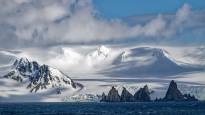The shape of the sea floor is causing the Thwaites Glacier to break up faster than scientists had previously thought.
The Thwaites Glacier, located in Antarctica, has been called the “Doomsday Glacier” in scientific circles because it has been known to be one of the most unstable glaciers and therefore prone to melting. According to new research results, it is even more unstable than previously believed.
A British-American team of researchers has published their latest findings on the condition of the Thwaites Glacier Nature magazine (you switch to another service) in the article.
The Thwaites glacier is 192,000 square kilometers in extent, i.e. roughly the same size as Finland without Lapland.
Changes in the extent of glaciers have been monitored since the early 1990s. The sea floor line of the Thwaites Glacier is known to have receded approximately 14 kilometers during this time. The seabed line refers to the edge where the glacier is still attached to the seabed. Outside, the glacier is on the surface of the water, forming a huge ice shelf.
Melting on the surface and below the surface
Currently, the Thwaites Glacier causes four percent (you switch to another service) observed sea level rise. Every year, the glacier loses about 50 billion tons more ice than it gains new snow cover. The researchers wanted to get more information, whether there are any noticeable changes in the melting rate.
The first observation of changes in the visible part of the glacier showed that the melting is slightly slower than the researchers had expected. More disappointing results were obtained from the bottom of the ice, however.
The researchers had at their disposal A robot camera called Icefin (you will switch to another service). The torpedo-shaped camera was obtained through a 600-meter-thick layer of ice by melting a hole in it with a hot water drill.
Icefin’s cameras revealed that the Thwaites Glacier is more fragile than previously thought. Warm seawater can penetrate cracks and crevices in the ice. As a result of melting, step-like formations have appeared on the lower surface of the ice.
– The warm water gets to the weak points of the ice and makes them even weaker, he says Interviewed by the BBC (you go to another service) researcher at Cornell University Britney Schmidtwho served as director of Icefin.
Researchers believe that the same phenomenon is also taking place in other Antarctic glaciers, meaning that the glaciers are more fragile than previously thought.
Thwaites Glacier feature
All glaciers move in such a way that their outer edge pushes towards the sea, where it crumbles into ice floes.
The attachment of the edge of the glacier to the seabed keeps the glacier in place, so that the crumbling remains slow. According to the researchers, if the glacier loses the same amount of ice to the sea as it gains new mass through rains, the glacier is in balance.
However, the Thwaites Glacier is no longer in balance, as it is constantly shrinking. A characteristic feature of Thwaites is that in some places the seabed deepens as you go towards the center of the glacier. This means that when the sea floor of the glacier recedes, a lot of warm water gets under the ice. This weakens the glacier exceptionally fast.
– Thwaites stays in place with his fingernails, he characterized to the Australian News website (you will switch to another service) geophysicist of the British expedition Robert Larter.
– We can expect big changes in a very quick time frame, he continued.
Larter did not specify what the big changes would be in practice. However, the melting of the glacier is accelerating. If the entire Thwaites Glacier melted, it would raise the sea level worldwide by about half a meter.
This would take tens of years anyway.
It is also worrying that although Thwaites is apparently one of the fastest melting glaciers, the same is happening in other Antarctic glaciers, many of which are significantly larger than Thwaites.
The melting of the Antarctic glaciers has major effects not only on the sea level, but also on sea currents, winds and marine ecology, says BBC in its analysis (you switch to another service).
From the satellite monitoring that started in the 1990s, it appears that the amount of ice in Antarctica has varied considerably. However, the trend has been decreasing. Last year, the amount of ice was the lowest during the research period, and this year a new record will be set for the amount of Antarctic ice.
What thoughts did the story evoke? You can discuss topic 2.3. until 11 p.m.
